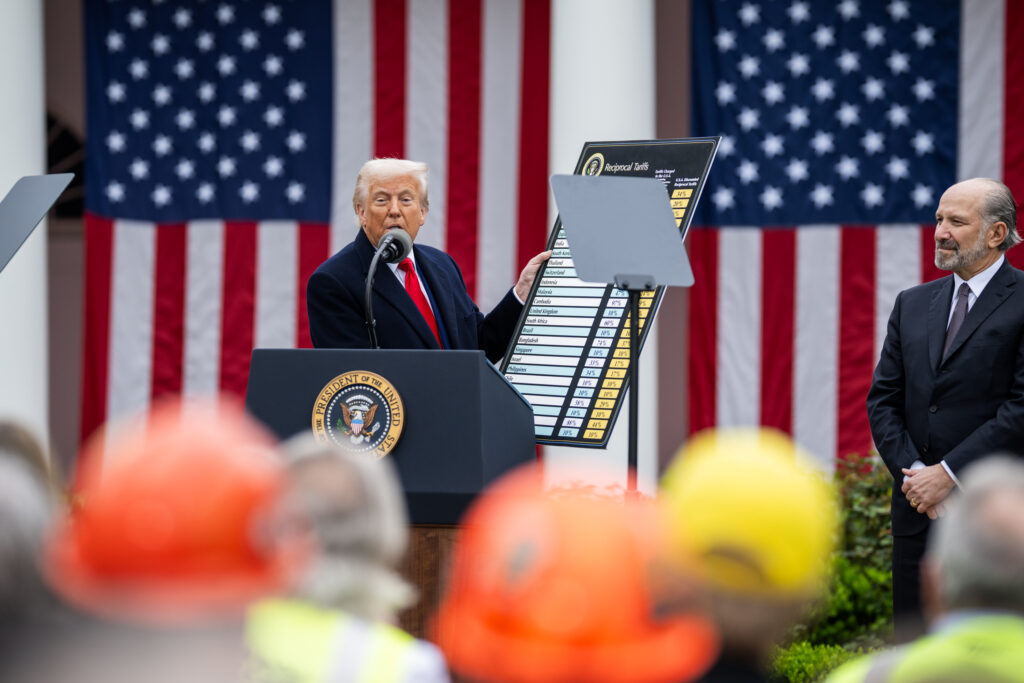The Peninsula
The Beef With Tariffs (I): South Korea’s True Tariff on U.S. Goods Is Far Lower Than White House Claims
Published April 3, 2025
Category: The United States

The market roiled, web searches spiked, and the media was in a frenzy after President Donald Trump unveiled his “Liberation Day” tariffs. Not surprisingly, the 10 percent baseline tariff on all goods with an additional “discounted” reciprocal tariff generated mostly negative reactions.
As the president held up a large placard explaining that nearly every country trading with the United States will be forced to pay new, heavier tariff rates, one number really stuck out and made an impression. It was the column labeled “Tariffs Charged to the U.S.A. including Currency Manipulation and Trade Barriers.” For South Korea, this figure was listed as 50 percent.

Source: Google Trend
The administration’s figure appears to be in line with other numbers leading up to this announcement, which peg South Korea’s tariff on U.S. imports anywhere between 8 percent and 13.6 percent. Both figures appear to be taken from the World Bank World Integrated Trade Solution (WITS) database with the lower bound seemingly representing the most favored nation (MFN) weighted mean or MFN applied weighted mean rate and the upper bound showing the MFN simple average.
But neither the simple average nor the MFN rate is the correct number to be referencing when talking about trade between South Korea and the United States.
As South Korean trade experts have noted, trade with the United States is largely dependent on the free trade agreement (KORUS FTA) implemented in 2012 and renegotiated six years later. The KORUS FTA’s tariff calculation for the U.S. is not subject to the MFN rate but to preferential treatment. The FTA has completely removed tariffs on U.S.-manufactured goods imported into South Korea. Measured in the value of imports, 95 percent of goods from the United States are completely exempt from South Korean import tariffs. To put it simply, MFN should not be the rate applied to U.S.-South Korea trade.
Simple average tariffs do not fully capture the unique nature of trade between any two countries. For instance, a simple average tariff can overstate the amount of protection for any given country if there are zero tariffs on high-import items but high tariffs on low-import items. To account for these kinds of features, one would need to look for average tariffs weighted by trade value. This is what trade experts refer to as the weighted average tariff rate or effective weighted average tariff. The problem with WITS was that they often used these numbers interchangeably until someone called them out on it not too long ago.
The weighted average or effective tariff is a fairer assessment of protectionism by any country (in this case, South Korea) since it represents the actual rate as it applies to the size of trade on an item-by-item basis between two countries for any given year. The math on this is relatively straightforward but our analysis of the U.S.-South Korea trade data, which the Korea Economic Institute (KEI) will release in a forthcoming report, is not as easy to calculate, since the data on this is somewhat sprawling, to say the least.
Our calculations indicate that South Korea’s effective tariff on US imports stands somewhere between 0.26 percent and 3.6 percent for 2023, and 0.19 percent and 2.9 percent for 2024, lending greater credence to the South Korean government’s official estimate of about 0.79 percent for 2024. Over time, this figure is only expected to decrease since almost all these tariffs were levied on agricultural imports using a quota schedule, much of which are set to expire in 2026.
By 2026, less than 0.5 percent of South Korean goods imports from the United States will be tariffed without any preferential treatment, thanks to the KORUS FTA.
The reciprocal tariff calculation provided by the USTR is a ratio of the trade balance and the value of imports. The problem with this is that the only type of fair trade according to this equation is one where there is no trade deficit There is no accounting for distortions like currency manipulation, non-tariff measures (NTMs), or non-discriminatory value added tax (VAT)—all of which were mentioned in a presidential memorandum issued on February 13 leading up to April 2 announcement.
Of course, we have more to say on these matters in the coming days with the release of our report. Stay tuned for more on this next week.
Dr. Je Heon (James) Kim is the Director of Public Opinion and External Relations at the Korea Economic Institute of America (KEI). Nils Wollesen Osterberg is Economic Policy Associate at KEI. The views expressed here are the authors’ alone.
Photo from The White House Flickr Account.
KEI is registered under the FARA as an agent of the Korea Institute for International Economic Policy, a public corporation established by the government of the Republic of Korea. Additional information is available at the Department of Justice, Washington, D.C.
